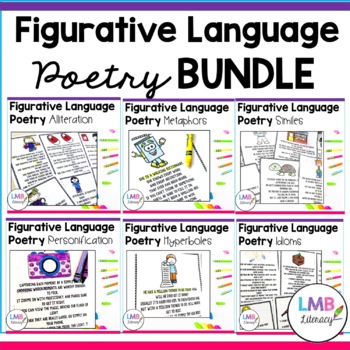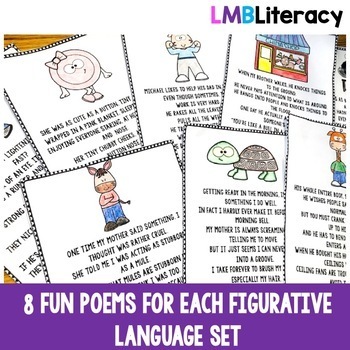Figurative Language Poetry Bundle, Poems with Poetry Comprehension
- Zip
- Easel Activity
What educators are saying
Products in this Bundle (6)
showing 1-5 of 6 products
Description
This figurative language poetry bundle is a great way to teach your students figurative language. Figurative language can be a difficult concept to comprehend. With these engaging, humorous poems, students will be able to learn the meanings of metaphors, similes, hyperboles, alliteration, idioms, and personification in a unique way! Also includes visuals on each poetry page as well as follow up comprehension questions These poems should be used as a supplemental resource after the definition of each figurative language concept has already been taught. In each set you will find:
~Table of contents
~Teacher tips
~8 Poems for each figurative language concept
~8 follow up comprehension question sets
Each set includes the following titles:
Metaphors:
*He Was So Boiling Mad*
*He's Such a Couch Potato*
*She is a Walking Dictionary*
*Her Homework is a Breeze*
*You Are a Star*
*You're Toast*
*He is the Class Clown*
*You're the Apple of My Eye*
Similes:
*As Busy as a Bee*
*As Stubborn as a Mule*
*As Strong as an Ox*
*Like a Bull in a China Shop*
*As Tall as a Giraffe*
*As Cute as a Button*
*As Fast as Lightening*
*As Slow as a Tortoise*
Idioms:
*A Piece of Cake*
*Costs an Arm and a Leg*
*Let the Cat Out of the Bag*
*Hit the Sack*
*Skating on Thin Ice*
*Break a Leg*
*Over the Moon*
*Can't Have Your Cake and Eat it Too*
Hyperboles:
*A Million Things To Do*
*So Hungry I Could Eat a Horse*
*You Could Move Mountains*
*Jump So High You Can Touch the Sky*
*The Weight of the World On Your Shoulders*
*Cry a River*
*Scared of Your Own Shadow*
*Never Stops Talking*
Personification:
*Clocks*
*Rocks*
*Cameras*
*Books*
*Trees*
*Pencils*
*A Blank Canvas*
*Clouds*
Alliteration for the Sounds:
*/ch/*
*/sh/*
*/p/*
*/r/*
*/t/*
*hard /c/*
*/f/*
*and /b/*
Notes To Customers! :)
Please click the star to follow me for more products and freebies!
If you enjoy a product, feedback is always welcomed and appreciated!
If you have any questions or concerns about a product, please contact me through the Q and A and I will get back to you ASAP!





